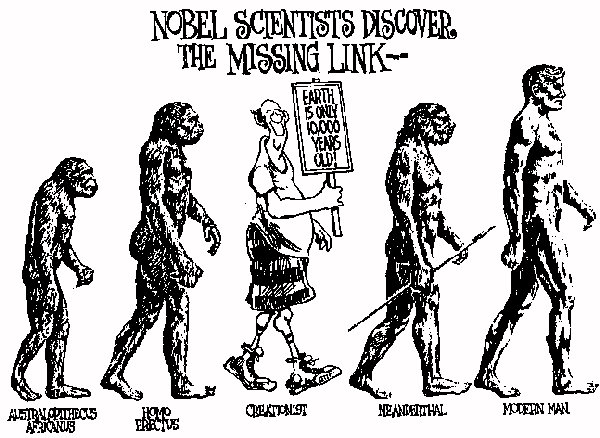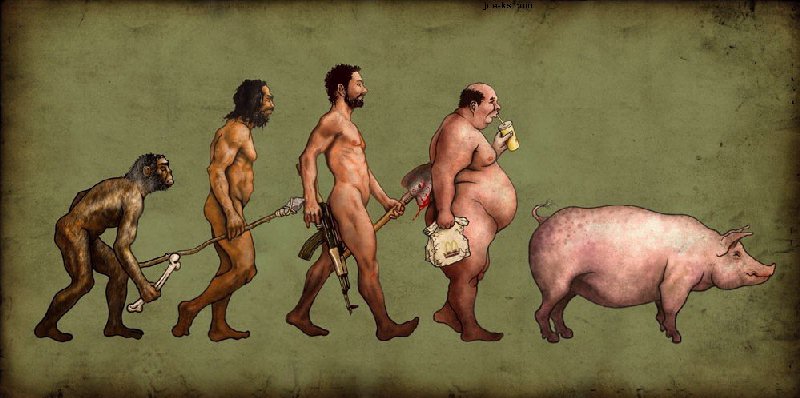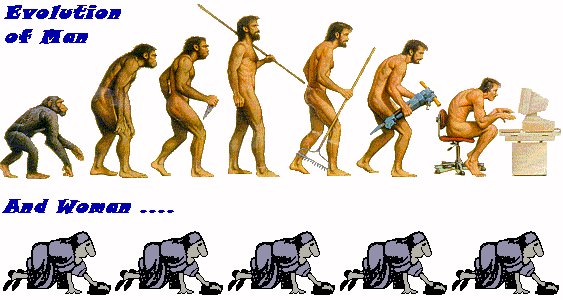| Homo Erectus Extinctus
The Health eZine - Reproduction
Evolution of Womb-man?Is nature determined to make men extinct? Senior scientists believe that women may evolve as humanity’s sole representatives — and social and political trends are lending weight to their theories. By the extrovert standards of our parliament, it is a surprisingly quiet debate, but one that will have all manner of implications. The Human Tissue and Embryos Bill, which is expected to become law next summer, says controversially that the fathers of artificially conceived children need not necessarily be recognised by the state. Are fathers destined to become redundant? The bill is a reflection of much wider scientific and social changes. The technology to produce artificial sperm, or even create offspring from two females, is already in the pipeline; in addition, genetic evidence has shown that the Y chromosome, the only one that confers maleness, is in a long-term evolutionary decline. And if that were not humiliating enough for men, in sizable communities across the country lesbians are not only forming partnerships, but they are openly bearing and raising children together, secure in the knowledge that British society now accepts such a lifestyle choice. Do men have a future at all?
The Y chromosome has scant function other than the production of sperm, and in many men it is not performing well. Male infertility is already surprisingly common: about 7% of men, or 1 in 13, are affected, often as a result of a defect in the coding mechanism for sperm production on the Y chromosome. Scientists hypothesise that there is more scope for errors in the DNA to build up: as it replicates in sperm production, “mistakes” can tend to creep into the Y chromosome. In fact, Y chromosomes only have about 27 genes – the rest of the chromosome is composed of “junk” DNA that does not code for anything. This process has gone even further in other species: in kangaroos, for example, the production of male offspring comes from one solitary gene on the Y chromosome. While other chromosomes pair up and swap DNA during the production of embryos, the Y chromosome in men does not do this. It is passed unchanged from generation to generation of fathers and sons, and while it has provided genealogists with a fascinating insight into the origins of entire communities, it has also raised other questions. The lack of ability to recombine means that Y chromosomes can’t repair themselves. A growing number of men have inherited a Y chromosome that was damaged during the production of their father’s sperm. There is considerable evidence that sperm counts are declining overall, and in some men the inherited damage to sperm production is so great as to render them infertile. Bryan Sykes, professor of human genetics at Oxford University and author of the book Adam’s Curse, is convinced that men will die out as the Y chromosome withers. He has calculated that, at the current rate of decline, heterosexual reproduction may only last around 125,000 years. “The core sex is female,” he says. “Male infertility is high because genes on the Y chromosome are packing up all the time. Many species become extinct because their Y chromosomes apparently disintegrate. In the end, the same thing will probably lead to the extinction of the male gender.”
The only glimmer of hope, he believes, may lie in the experience of the mole vole. This tiny rodent native to the Caucasus mountains of central Asia seems to have lost its Y chromosome somewhere down the evolutionary millennia, but the genetic material that confers maleness has nimbly transferred itself to another chromosome. If the Y chromosome turns out to be as useless as Sykes suggests, it would be possible to move the human SRY (the sex-determining region of the Y chromosome) and associated “maleness” genes to another chromosome and produce males with two X chromosomes. A surprising number of animals can reproduce without male involvement if there is no other option. Sharks and lizards have demonstrated this ability in captivity. It was previously believed that the process was impossible in mammals such as humans because male sperm cells and female egg cells undergo a process called imprinting. In imprinting, sections of each cell’s genome are silenced to allow the set of genes from the other parent to be expressed, so that when the egg and sperm cells combine, the genes in the resulting embryo are not competing with each other. It has now been discovered that it is possible to interrupt this process by deleting just two sections of genetic material on the genomes of female mice – animals very similar, for reproductive purposes, to humans. Immature egg cells that have not begun any of the rest of the imprinting process are fused with a mature egg from another mouse, and activated by an electric current to begin dividing. These new cells will produce a ball of cells just like a normal early embryo. Elsewhere, producing a child that is the genetic offspring of two females is becoming a real possibility – and the process is not nearly as difficult as was previously thought. Artificial sperm produced from bone-marrow cells has already led to pregnancies and live births in mice. Last summer a Japanese team announced that female mice had been made pregnant using cells from other females, and given birth to completely healthy babies. The success rate was about one in five, roughly the same as that achieved by human infertility clinics. The only drawback was that the baby mice grew into adults that were on average 20% smaller than normal mice, but the researchers expect to rectify this problem once the imprinting process is better understood. Their message is that there is nothing unique provided by the male in sexual reproduction – only properly imprinted chromosomes for the production of a new human baby.
Others are keener to help keep men going. One of the world leaders in the field, Karim Nayernia, professor of stem-cell biology at Newcastle University, has already shown that unlimited sperm can be derived from early stem cells present in an embryo. He has also proved that it is possible to overcome the shortage of donor sperm by using the stem cells stored in bone marrow, generally destined to provide replacement blood cells on demand. Such manufactured sperm would initially be used to restore fertility in men made sterile by cancer treatment, but the technology has other possibilities. Nayernia is awaiting ethical approval to see if he can also produce synthetic sperm cells from women’s stem cells. “We want to see if we can test the functionality of female sperm produced in this way,” he said. “There would be no possibility of using it for human reproduction. We want to use it to make other tissues.” He acknowledges, however, that scientists cannot control the use of such knowledge. Once the technology is there, it will be very attractive to lesbians. How long before it is routinely used is another question. “The timescale will be dictated by ethical concerns rather than scientific ones.” Bill Ledger, professor of obstetrics and gynaecology at the University of Sheffield, is among the British infertility experts who over the past four decades have presided over the creation of tens of thousands of babies by IVF. “The traditional model of a normal family is long gone in the West,” he says. “It is unjust to allow gay people to have equal-partnership rights and not allow them to have children. The shortage of human sperm donors will inevitably increase pressure for novel methods of reproduction. There is no evidence of harm to children brought up in nonconventional families, though it will be some time before we know if the research on this is right or not.” Meanwhile, the Human Tissue and Embryos Bill may be recognising the new approach to parenthood put forward by the lesbian community, but it will also open a new can of worms by redefining parenthood as a legal responsibility rather than a biological relationship. The proposed legislation makes provision for a child to have two female parents, but there is no discussion of the concept of a female father. Earlier this year the parliamentary committee that scrutinised the bill said that if the technology becomes available to create a baby without the need for male involvement, then “any question of whether such an embryo should be allowed to be inserted into a woman should be a matter for parliament to decide”. It is a comment almost touching in its naivety. It is not a question of if, but when – and it is also highly unlikely that the first such babies will be created here. The most up-to-date research suggests that this might happen in 5 to 10 years. British women wanting such a child will simply go abroad for the treatment, and parliament will be one of the last places to hear about it.
|




|

While scientific developments and research are undermining the traditional function of men – particularly as fathers – a blossoming of the lesbian community is having an equally profound impact. Marie Piper conceived her baby on her honeymoon. While there is nothing particularly remarkable about that, the precise manner of the conception is more unusual. Instead of going about procreation in the normal way, the baby’s father handed over a total of eight plastic bags of semen in the foyer of the London hotel where Marie was staying for the weekend, and left the rest to her. Marie was not spending her nights with another man, but celebrating the public recognition of a civil partnership with another woman, Jill Greenfield, with whom she has lived for the past seven years. A baby boy the two women have named Joseph was the product of the hotel transaction. While they both actively wanted the name of the biological father on the birth certificate, and expect him to have some involvement in Joseph’s life, it will be at arm’s length. They regard the baby, who is now six months old, as their child. They are hoping to have a sibling next year from the same donor, and might even have more children to complete their family. In Hebden Bridge, West Yorkshire, where the two women live, this arrangement has aroused no comment. The affluent Pennine community, with its smart delicatessens and organic grocers, has become an unlikely centre for Britain’s burgeoning community of lesbian families. Up to one in five of the population of 13,000 is a gay woman. Lesbian couples own many of the bars, restaurants, galleries and other businesses that line the Rochdale canal and the nearby River Calder. Although other large cities have significant gay populations, the concentration in Hebden Bridge is probably greater than anywhere else in the UK. And it is getting bigger. In Marie’s antenatal yoga classes last year, no fewer than 4 out of 10 of the other mothers were part of lesbian couples. A similar trend is recognisable nationwide. Data from the Human Fertilisation and Embryology Authority, which regulates fertility treatments and embryo research, indicate that within two years there will be more lesbian couples, or women who identify themselves simply as “single”, having children by using donor sperm than heterosexual couples. Of the 3,864 women who had donor insemination last year, 1,472 were not in heterosexual relationships. Infertility doctors widely acknowledge that while many of this latter group are heterosexuals without husbands or boyfriends, many more single women define themselves as such simply to avoid intrusive questions about their sexuality. In some parts of the country, women’s civil-partnership ceremonies outnumber those involving men. Overall, there were 18,059 such unions in the first year they became available. The government’s prediction of little more than 2,000 per year showed the inaccuracy of official estimates of the size of Britain’s gay community.
The Kinsey reports on human sexuality, conducted on Americans half a century ago, suggested that only 10% of people of each gender were totally heterosexual, with another 10% totally homosexual. Most people, Kinsey argued, lie somewhere on a continuum between gayness and straightness. The social trend that we are witnessing indicates many more women than expected could be migrating towards lesbianism. Fear of public outrage has deterred governments from including questions of sexual orientation on the national census, but the size of gay communities in Britain’s cities now makes it impossible to ignore them. In Hebden Bridge, where lesbian couples proudly stroll around with their babies with the same assurance as heterosexuals, you might think this alternative society is utterly unremarkable. “Women come here because they feel at home,” says Piper, 28, an English graduate from Leeds University who until her maternity worked in academic administration. “There are now so many lesbians here that nobody really thinks of our lifestyle as anything unusual.” Her civil partner, Jill Greenfield, 37, works as a charity manager. On Wednesday nights she goes to football training. Marie minds the baby. Like many lesbians, she always knew she wanted children, and she tried to form relationships with boys, but she also knew from childhood that she would fall in love with a woman. She now moves in a circle of entirely like-minded women. Her social group includes six lesbian couples with babies all born within six months of Joseph. Half were conceived through donor sperm from clinics, and the others were arrangements like hers, where a gay friend or acquaintance agreed to provide the sperm. Such arrangements are extremely fraught. There are long waiting lists for donor sperm at infertility clinics because of a chronic shortage caused by new laws allowing children conceived by donor sperm to track their genetic fathers. With informal arrangements, the father runs the risk of being approached for financial support for the child, even years after its conception, as has happened in the case of the fireman Andy Bathie, 37, of Enfield, north London, who is being pursued for child support for two children produced from his sperm donation to a lesbian couple who have now split up. Even so, the number of lesbian families is rocketing. Most lesbians say women would prefer to use sperm from a donor they know than incur the expense of going through a clinic, but the number of lesbians having donor insemination from clinics has risen by 6% in the past year alone. Having secured the right to legal recognition of their relationships through the provision for civil partnership, many lesbians are now seeking equal parenting rights to heterosexual couples, by asking for a child’s second, nonbiological mother to take the legal role of father. The Human Tissue and Embryos Bill will allow for a second woman, rather than a man, to be treated as a child’s parent. How this will be expressed on birth certificates has yet to be fleshed out. The implications of these huge changes in the definition of “family” are generating unease. Joseph’s parents, and most other lesbian couples interviewed for this article, were keen to maintain contact with their children’s natural fathers, but a growing number are not. Precise figures for the size of this group are impossible to come by, but one woman, who did not want to be identified, said she had made it clear from the outset that she did not want her teenage son to contact his biological father. “I don’t believe the genes have much to do with it,” she said. “My son is entirely heterosexual, but I don’t really want his father to try to have any input into how he grows up. I want all the parenting to come from me. I don’t want him to form an attachment to a man who has nothing at all to do with our lives.” If the debates on artificial sperm and the decline of the Y chromosome were not enough to dismay any man – or indeed any woman with sons – there is growing evidence that women are outstripping men intellectually. Sociologists and education specialists are bemoaning the continuing triumph of girls over boys at every level of the education system, leading to the inevitable question of whether the male gender is reaching the end of its natural usefulness. It is an issue that has been much discussed in literature for more than a century. Herland, a science-fiction novella of 1915 by the American feminist Charlotte Perkins Gilman, describes a utopia where women, “the natural co-operators”, reproduce by parthenogenesis. The previous existence of men is consigned to legend. Similar scenarios have been described in more recent science fiction, such as the French writer Elisabeth Vonarburg’s 1993 novel In the Mothers’ Land, where a few women breed with men but the majority use artificial sperm.
Earlier this year the Bow Group, a right-wing think-tank, reported that only 144,000 boys a year were going into further education, compared with 167,000 girls. This superior school performance is contributing to girls’ progress in catching up with men in economic terms. A recent report by the Future Foundation predicted that women in their twenties earn 96% of the pay earned by men, and within the next decade will earn more than men because of their higher educational attainments and skills. And within 20 years, women would be the main breadwinners in one in four families. Other studies have highlighted the new phenomena of female medical graduates outnumbering men and the preponderance of women receiving first-class degrees. Jon Pickering, a lecturer in school effectiveness and school improvement at the Institute of Education in London, says it is impossible to predict how the male sex will react to a world where “effortless achievement” is no longer their right. “Generations of girls are now coming through who are aware of the fact that they can do better than men,” he says. “It will have an effect on the balance of society. If men can no longer achieve anything very much, what exactly is going to be left for them?” If, as is often observed, women do the lion’s share of the domestic duties in most homes, the question of whether they will continue to find men necessary becomes more pressing. A number of academics think that if you remove men’s higher earning power and their unique ability to father children, more women will inevitably choose to live with other women. Women are increasingly admitting to a willingness to experiment in sexual relationships with other women instead of men. Last year the American Centers for Disease Control and Prevention (CDC) reported the number of adult women having lesbian sex had almost trebled, from 4% to 11.5%, in one decade. Researchers such as John Bancroft, the British-born former director of America’s Kinsey Institute for Research in Sex, Gender and Reproduction, says surveys in Britain and Australia have produced similar findings to the CDC, but he argues that women’s sexuality is more fluid, and that bisexual tendencies may have little significance. Gay academics predict a social sea change. Gregory Woods, professor of gay and lesbian studies at Nottingham Trent University, draws a parallel between dwindling disapproval of lesbianism and the change in attitudes to “spinsterhood” and women living alone towards the end of the last century. “It used to be thought there was something improper about a woman not marrying and seeking to live alone,” he said. “The taboos about women’s behaviour are weakening, and these alternative methods of having babies will change things more, but I think it will happen over decades rather than years.” Where all this will lead is anyone’s guess. “Our society has embarked on a vast social experiment in producing children designed to have no human relations with some of their biological relatives…permanently severed from their biological past…by deliberate intention,” said David Velleman, professor of philosophy at New York University. There is disquiet in the UK too. Brenda Almond, emeritus professor of moral and social philosophy at the University of Hull, is the author of a recent book called The Fragmenting Family. She is at pains to stress her even-handed attitude to lesbians, but fears that the drive to recognise lesbian families may cause us to discard something of significant value. “You are losing the possibility of having a caring or involved parent of the opposite sex,” she says. “I feel very strongly that birth certificates should fulfil their original function of giving information about a person’s biological origins. They should not be reduced to being a sort of social record.” It seems unlikely these rumblings of protest will have any impact on the juggernaut of changing social attitudes – especially as the growing preference for homosexual child-rearing is being fuelled by scientific developments that will see artificial sperm available for human use in 5 to 10 years. The definition of a child’s biological origins will therefore change in a way never before seen in the history of mankind.
 | |




